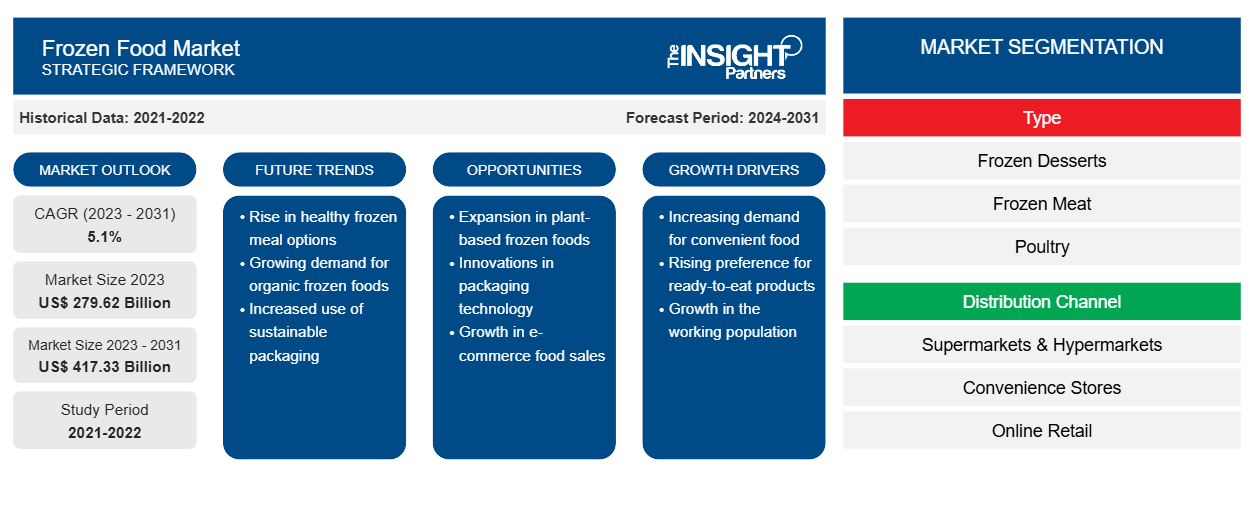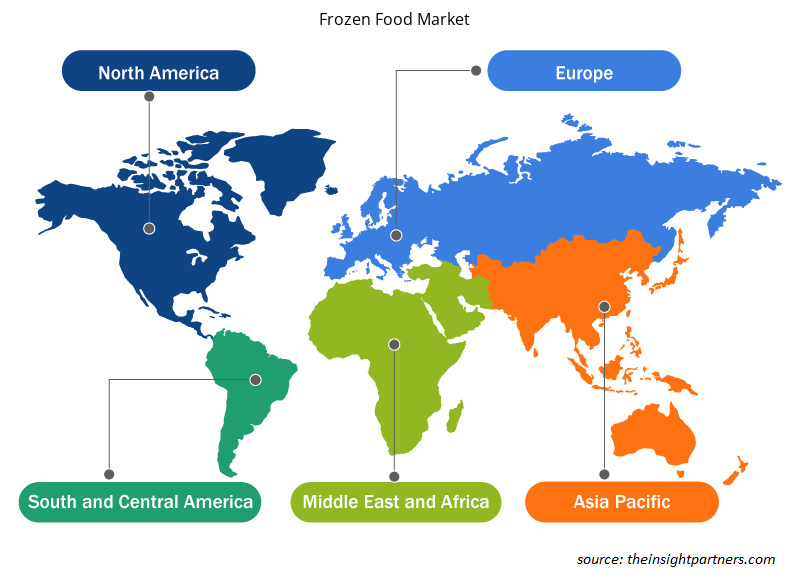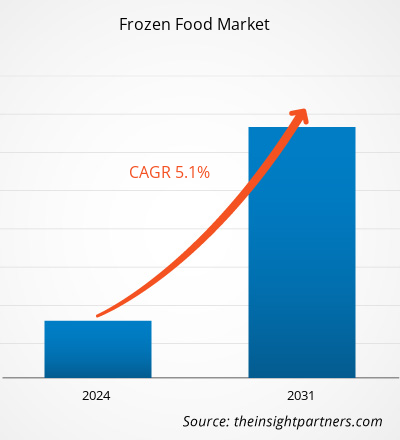冷凍食品市場規模は、2024年の2億9,539万米ドルから2031年には4億4,422万米ドルに達すると予測されており、予測期間中は年平均成長率(CAGR)6.0%を記録する見込みです。近年、ビーガン主義は大きな勢いを増しています。消費者は、従来の食品よりも健康的であると認識しているため、植物由来製品への強い関心を示しています。さらに、動物保護と環境の持続可能性に関する意識の高まりも、これらの食品の人気を高めています。世界中で広がるビーガン主義の波は、冷凍食品市場におけるイノベーションに大きな影響を与えています。
冷凍食品市場分析
ここ数年、世界中の人々のライフスタイルは劇的に進化しました。多忙な仕事のスケジュールにより、時間と労力を節約できる製品への依存度が高まっています。高品質なインスタント食品の消費量の急増は、食品業界における最大のトレンドの一つです。冷凍スナック、冷凍食品、コールドカット、インスタント食品などのインスタント食品は、食材の買い物、食事の準備と調理、消費、そして食後の活動に伴う時間と労力を消費者に節約します。これらの食品の発展と人気は、多くの社会変化に起因していますが、その中で最も顕著なのは、小規模世帯の増加と、世界中で増加するミレニアル世代の人口です。多忙な仕事のスケジュールにより、ミレニアル世代は退屈な作業に時間を費やすよりも、時間を効率的に使うことを好みます。そのため、彼らはインスタント食品にお金を使う可能性が高くなります。これらの要因が消費者のインスタント食品の需要を大幅に押し上げ、最終的には冷凍食品市場の成長を後押ししています。
冷凍食品市場の概要
冷凍食品には、アイスクリーム、フローズンヨーグルト、冷凍肉、冷凍シーフード、冷凍惣菜、スナック、前菜、スープ、果物、野菜などが含まれます。これらの製品は、約-25℃で冷凍保存されます。冷凍食品は人工保存料を含まないため、他の加工食品よりも健康的です。さらに、家庭用冷凍庫で華氏0度に簡単に保存できます。人々の多忙なライフスタイルに伴うインスタント食品の需要の高まりが、冷凍食品市場の成長を牽引しています。さらに、急速な都市化、一人当たりの所得の増加、そして小売環境の変化も、冷凍食品市場の成長を牽引する主要な要因となっています。
要件に合わせてレポートをカスタマイズ
このレポートの一部、国レベルの分析、Excelデータパックなど、あらゆるレポートを無料でカスタマイズできます。また、スタートアップや大学向けのお得なオファーや割引もご利用いただけます。
冷凍食品市場:戦略的洞察

-
このレポートの主要な市場動向を入手してください。この無料サンプルには、市場動向から見積もりや予測に至るまでのデータ分析が含まれます。
冷凍食品市場の推進要因と機会
電子商取引の隆盛が市場を有利に導く
冷凍食品の購入にオンライン小売プラットフォームを利用する人が増えています。米国冷凍食品協会によると、2020年の冷凍食品のオンライン販売は75%増加しました。パンデミックの間、実店舗の閉鎖と政府による社会的制限の導入により、食品と飲料のオンライン販売は大幅に増加しました。ロックダウンにより人々の移動が制限され、在宅勤務を余儀なくされたため、オンラインショッピングへのシフトが顕著になりました。さらに、大幅な割引、様々なブランドの幅広い品揃え、宅配オプションも、消費者がオンラインショッピングに目を向ける要因となっています。様々な地域でeコマースが普及するにつれ、ケロッグ社やコナグラ・ブランドなどの冷凍食品メーカーも、Amazon.com、Lidl、Walmartなどの有名eコマースプラットフォームを通じて製品を販売することで、オンラインでの存在感を高めています。この要因は、オフラインの小売店への依存をなくし、冷凍食品市場の成長に貢献しています。
メーカーによる戦略的開発イニシアチブ - チャンス
冷凍食品メーカーは、顧客基盤の拡大と新たな消費者トレンドへの対応を目指し、製品イノベーションに多額の投資を行っています。グルテンフリー、植物由来、無糖、オーガニック、クリーンラベル製品に加え、ケトダイエットに適した製品も発売しており、消費者の多様なニーズに応えています。例えば、2021年8月、冷凍食品業界で名を馳せるリアル・グッド・フーズ・カンパニーは、全米1,500店舗のクローガーで、高タンパク質、低炭水化物、穀物不使用、グルテンフリーの冷凍食品7カテゴリーを新たに発売すると発表しました。同様に、2022年には、インドの大手冷凍食品ブランドであるプラスマが、冷凍スナック製品を新たに発売しました。新たに発売された製品は、冷凍野菜とチキンの春巻き、冷凍チキンナゲット、チキンと野菜のミニサモサ、チキンとマトンのシャミカバブ、シークカバブ、そしてベーコンです。これらの製品は、世界的な危機の中で世界中の消費者が健康を最優先とする中で、消費者が健康目標を維持し、健康的な食事を楽しめるよう支援するために発売されました。人々が食事の栄養バランスを維持しながら、簡便な食品に注目するようになったため、メーカーは栄養価の高い冷凍食品を発売しています。こうした製品イノベーションは、メーカーの市場拡大と国際市場における競争力強化に役立っています。
冷凍食品市場レポートのセグメンテーション分析
冷凍食品市場分析の導出に貢献した主要なセグメントは、タイプと流通チャネルです。
- 冷凍食品市場は、種類別に、冷凍デザート、冷凍肉・鶏肉・魚介類、冷凍ベーカリー、冷凍スナック・前菜、冷凍食品、その他に分類されます。
- 流通チャネルの観点から見ると、市場はスーパーマーケットやハイパーマーケット、コンビニエンスストア、オンライン小売、その他に分かれています。
冷凍食品市場シェアの地域別分析
冷凍食品市場レポートの地理的範囲は、主に北米、アジア太平洋、ヨーロッパ、中東およびアフリカ、南米/中南米の 5 つの地域に分かれています。
冷凍食品市場はヨーロッパが優勢を占めています。ヨーロッパの冷凍食品市場は、ドイツ、フランス、イタリア、イギリス、ロシア、その他ヨーロッパ諸国に区分されています。市場の成長は主に、インスタント食品の需要の高まり、充実した小売インフラ、そして様々な流通チャネルを通じた様々なブランドの幅広い製品の入手可能性に起因しています。さらに、一人当たり所得の高い消費者の存在も、冷凍食品(冷凍食品、食事、スナックなど)の需要を牽引しています。消費者は、消費する製品に栄養上の利点を求めています。そのため、クリーン、オーガニック、グルテンフリー、そして最小限の加工のみで作られた冷凍食品の需要が大幅に増加し、この地域の市場成長を後押ししています。
冷凍食品市場の地域別分析
Insight Partnersのアナリストは、予測期間を通じて冷凍食品市場に影響を与える地域的な動向と要因を詳細に解説しています。このセクションでは、北米、ヨーロッパ、アジア太平洋、中東・アフリカ、中南米における冷凍食品市場のセグメントと地域についても解説します。

- 冷凍食品市場の地域別データを入手
冷凍食品市場レポートの範囲
| レポート属性 | 詳細 |
|---|---|
| 2024年の市場規模 | 2億9,539万米ドル |
| 2031年までの市場規模 | 4億4,422万米ドル |
| 世界のCAGR(2025年~2031年) | 6.0% |
| 履歴データ | 2021-2023 |
| 予測期間 | 2025~2031年 |
| 対象セグメント |
タイプ別
|
| 対象地域と国 |
北米
|
| 市場リーダーと主要企業の概要 |
|
冷凍食品市場のプレーヤー密度:ビジネスダイナミクスへの影響を理解する
冷凍食品市場は、消費者の嗜好の変化、技術の進歩、製品メリットへの認知度の高まりといった要因によるエンドユーザーの需要増加に牽引され、急速に成長しています。需要の増加に伴い、企業は製品ラインナップの拡充、消費者ニーズへの対応のための革新、そして新たなトレンドの活用を進めており、これが市場の成長をさらに加速させています。
市場プレーヤー密度とは、特定の市場または業界内で事業を展開する企業または会社の分布を指します。これは、特定の市場空間における競合企業(市場プレーヤー)の数が、その市場規模または市場価値全体と比較してどれだけ多いかを示します。
冷凍食品市場で事業を展開している主要企業は次のとおりです。
- コナグラブランド
- ゼネラルミルズ
- ペパリッジファーム株式会社
- ボンデュエルグループ
- マケインフーズ・リミテッド
- ベリシオフーズ株式会社
免責事項:上記の企業は、特定の順序でランク付けされているわけではありません。

- 冷凍食品市場のトップキープレーヤーの概要を入手
冷凍食品市場のニュースと最近の動向
冷凍食品市場は、主要な企業出版物、協会データ、データベースなどを含む一次調査および二次調査を経て、定性・定量データを収集することで評価されます。以下は、言語障害市場における動向と戦略のリストです。
- 2022年、ホワイトキャッスルはベリシオフーズとの提携により小売食品の提供を拡大し、象徴的なチキンリングを全国の小売店に提供します(ホイッスルキャッスル/会社ウェブサイト)
冷凍食品市場レポートの対象範囲と成果物
「冷凍食品市場規模と予測(2021〜2031年)」レポートでは、以下の分野をカバーする市場の詳細な分析を提供しています。
- 対象範囲に含まれるすべての主要市場セグメントの世界、地域、国レベルでの市場規模と予測
- 市場の動向(推進要因、制約要因、主要な機会など)
- 今後の主な傾向
- 詳細なPEST/ポーターの5つの力とSWOT分析
- 主要な市場動向、主要プレーヤー、規制、最近の市場動向を網羅した世界および地域の市場分析
- 市場集中、ヒートマップ分析、主要プレーヤー、最近の動向を網羅した業界の展望と競争分析
- 詳細な企業プロフィール
- 過去2年間の分析、基準年、CAGRによる予測(7年間)
- PEST分析とSWOT分析
- 市場規模価値/数量 - 世界、地域、国
- 業界と競争環境
- Excel データセット
最新レポート
関連レポート
お客様の声
購入理由
- 情報に基づいた意思決定
- 市場動向の理解
- 競合分析
- 顧客インサイト
- 市場予測
- リスク軽減
- 戦略計画
- 投資の正当性
- 新興市場の特定
- マーケティング戦略の強化
- 業務効率の向上
- 規制動向への対応






















 無料サンプルを入手 - 冷凍食品市場
無料サンプルを入手 - 冷凍食品市場